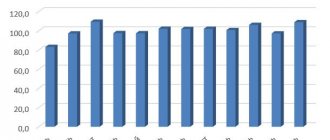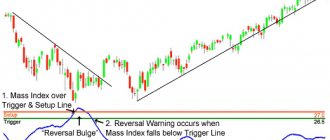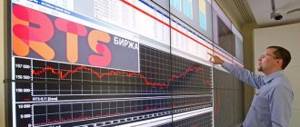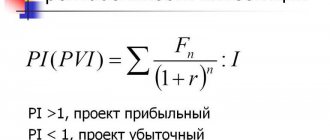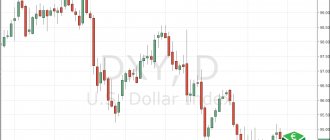olegas Jan 14, 2021 / 139 Views
The Producer Price Index (PPI) is a group of indices that calculate and present the average change in selling prices for materials and components for producers of goods and services.
- Real example of using PPI
- Types of PPI
- PPI classification
What does the PPI show?
It is not a direct indicator of inflation (unlike the CPI), but its growth may be its precursor. After all, increased selling prices will lead to an increase in the cost of manufactured products and manufacturers will try to shift these costs onto the shoulders of their end consumers (that is, you and me).
Thus, the producer price index can be called an early indicator of inflation.
But, on the other hand, an increase in the PPI does not always mean that the consumer price index will increase and the inflation rate will rise. There are three main reasons:
- An increase in the price of raw materials, materials or components can be compensated by the manufacturer by reducing any other cost items;
- Even if a manufacturer increases selling prices for its products, this will not necessarily lead to an increase in retail prices for them. Retail chains can also compensate for this increase in price by reducing their other expenses;
- An increase in the producer price index does not necessarily lead to an increase in the consumer price index for the simple reason that they are calculated based on different sets of goods. The PPI includes the dynamics of prices for industrial goods, and the CPI for a certain basket of consumer goods, and in addition also includes services.
Calculation of pixel density (PPI) of a monitor
Theoretically, PPI can be calculated from the screen diagonal size in inches and the resolution in pixels (width and height). This can be done in two steps:
1. Calculate the diagonal resolution in pixels using the Pythagorean theorem:
dp=wp2+hp2{\displaystyle d_{p}={\sqrt {w_{p}^{2}+h_{p}^{2}}}}
2. Calculate PPI:
PPI=dpdi{\displaystyle PPI={\frac {d_{p}}{d_{i}}}}
Where
- dp{\displaystyle d_{p}} — diagonal resolution in pixels,
- wp{\displaystyle w_{p}} — resolution width in pixels,
- hp{\displaystyle h_{p}} - resolution height in pixels and
- di{\displaystyle d_{i}} - diagonal size in inches (this number is declared as the display size.)
For example, for a 21.5-inch (54.61 cm) screen with a resolution of 1920x1080 (in which wp{\displaystyle w_{p}} = 1920, hp{\displaystyle h_{p}} = 1080 and di{\ displaystyle d_{i}} = 21.5), we get 102.46 PPI; for a typical 10.1-inch netbook screen with a resolution of 1024x600 (in which wp{\displaystyle w_{p}} = 1024, hp{\displaystyle h_{p}} = 600 and di{\displaystyle d_{i}} = 10.1), we get 117.5 PPI.
Please note that these calculations may not be very accurate. Often screens advertised as "X-inch screen" may have different actual physical dimensions of the viewable area, for example:
- The mid-2011 Apple iMac is advertised as a "glossy 21.5-inch widescreen TFT display," but its actual viewable area is 21.465 inches or 545.21mm instead of the intended 546.1mm. More precise figures increase the estimated PPI from 102.46 (at 21.5) to 102.63.
- The HP LP2065 20-inch (50.8 cm) monitor has a real viewable area of 20.1 inches (51 cm).
Calculation methodology
The methodology for calculating the producer price index involves the following steps.
- Selection of basic industries. The methodology for calculating the PPI index assumes that it covers all basic industries: mining and processing industries, light industry, mechanical engineering, agriculture, etc. Its value can be calculated for each individual industry and for the entire economy as a whole.
- Selecting a set of industrial products participating in the index. The main task at this stage is to create a representative sample that would objectively take into account the structure of manufactured industrial goods and consumed raw materials in each industry. The quality of the sample will directly determine the exact calculation of the inflation target.
- Determination of weighting coefficients for each product. At this stage, it is necessary to objectively assess the share of each industrial product included in the PPI index so that the target inflation rate objectively reflects changes in the price level in industry.
In addition, the calculation methodology must take into account regional aspects, namely the fact that in different regions the price level for industrial goods may differ significantly.
Using PPI on Android
Required graphic resources, Chrome example
The DPI appended naming suggested here is optional and not presented in the official Android guides. Due to limitations in current design tools, this is what we call our graphics assets due to limitations in current design tools that make it difficult to define specific paths for exporting graphics assets. Considering that a graphic resource source can sometimes contain hundreds of graphic resources, it is less painful to do the export process and avoids duplication of names errors on the part of the designer. In the source storage, graphic resources are structured as follows: - drawable-mdpi/asset.png - drawable-hdpi/asset.png
- etc. ...
Android has 7 different DPIs, you need to worry about 4: mdpi, hdpi, xhdpi, xxhdpi plus XXXHDPI if you want to futureproof your app. MDPI is the base DPI or your 1x multiplier Android uses dp instead of pt for the spec but they are the same Round to the side that works best for you for multipliers with decimal places. Submit your work in .png images. Discuss the naming convention and export process with the person responsible for implementation.
The difference between the PPI and the consumer price index
The PPI measures changes in prices from the point of view of the seller and this is its fundamental difference from a similar indicator called the consumer price index (CPI) and reflects changes in prices from the point of view of buyers (end consumers of goods and services). In other words, this index tracks changes in the cost of production.
Another difference is that the PPI takes into account only prices of goods (and only at the wholesale level), while the consumer price index includes both prices of goods and prices of services.
Vector design
There are a couple of practical lessons you should take away from all of this. To begin with, you should create your designs in vector. This allows our interfaces, icons and other graphics to scale to any size needed.
Second lesson: we must draw everything on a 1x scale. In other words, create a design using points for all dimensions, then scale to various larger pixel densities when exporting. Scaling 2x graphics by 150% to create a 3x version results in blurry edges, so it's not the best option. But scaling 1x graphics at 200% and 300% allows you to maintain clarity.
The resolution of iPhone app layouts should not be 750x1334, but 375x667 - this is exactly the resolution in which the application will be displayed. Most designer tools don't differentiate between points and pixels, so you can assume points are pixels and then simply export the source at 2x or 3x size.
What types of PPI are there?
The PPI index is divided into two types, depending on the calculation method:
- PPI input index or PPI at the input
When calculating PPI input, changes in prices for components and semi-finished products are taken into account. It should be noted that this indicator does not always affect the inflation index, as it can be compensated by a decrease in production costs. However, under normal circumstances, PPI input is a strong indicator of future inflation.
PPI input data does not have a significant impact on the Forex market. The exception is the moment when the actual index value differs significantly from the consolidated forecast.
- PPI output index or output PPI
Producer price index PPI output determines changes in selling prices for goods and finished products in industry, as well as changes in labor costs. PPI output reflects inflationary pressure on the country's economy from manufacturers and exporters.
How is Producer Price Index calculated?
The Producer Price Index has a fixed set of weights; it tracks changes in the prices at which national producers sell their goods at the wholesale level. Producer Price Index covers all stages of production: finished products, intermediate stages, raw materials; and all sectors - agriculture, mining, industry. The PPI does not include the prices of imported goods, but they influence the index through the prices of imported components and raw materials. This is the main difference between the producer price index and the consumer price index: PPI covers exclusively goods at the level of their wholesale sales.
Every month, when calculating the PPI index, the US Bureau of Employment Accounting analyzes approximately 3,500 products and includes them in the indicator depending on their contribution to the country's GDP. The proportions according to which goods are taken into account in the PPI index are as follows:
- consumer goods, cars – 40%;
- food products – 23%;
- energy products, including gasoline and other fuels – 14%.
The remaining 23% comes from other products, equipment, cars (cars are counted twice in the PPI index as a consumer product and a means of production).
Index calculation
The calculation is carried out based on current prices of industrial goods related to their prices in the base period. First, the change in price is calculated for each individual component of the index:
PPIi—change in price for individual i-th industrial product;
Ct is the price of the i-industrial product in the current period of time;
CB is the price of the i-industrial good in the base period.
Then its value itself is calculated:
n – the number of industrial goods included in the index;
Zi is the specific weight of each product that makes up the index.
In Russia, the calculation of the index is carried out by the Federal State Statistics Service (Rosstat). It is published monthly on the official Internet resource of the department https://www.gks.ru/bgd/free/B00_24/IssWWW.exe/Stg/d000/I000870R.HTM. Moreover, the current index is calculated based on the index of the previous month.
Types of applications, how they scale (or don't scale)
| DPI-Aware flag is not set | DPI-Aware flag is set | |
| Not DPI-Aware | Need to use DPI virtualization | Need fixes from developers |
| DPI-Aware | Need to use Windows XP style scaling | Always scales correctly |
Applications that don't care about DPI at all
incorrect screenshots
Applications that can adjust their GUI to different DPI values, but do not have a DPI-Aware flag Applications that can adjust their GUI to different DPI values, which have a DPI-Aware flag Applications that are not adapted to DPI changes, but have a DPI-Aware flag
JavaFX
Choosing a scaling method for your applications
- If you are so incredibly lucky to only use applications that are both DPI-Aware and set the desired flag, then it doesn't matter which scaling method you choose. All applications will use Windows XP style scaling and DPI virtualization will never be used.
- If you only use well-written DPI-Aware applications, but some of them do not set the required flag, you can disable "DPI virtualization". This way, all applications will be displayed correctly without any blurring due to scaling. If your monitor has a very high pixel density, such that scaled bitmaps no longer appear blurry, you may want to enable DPI virtualization anyway.
- If you have one or more applications that are not adapted to DPI changes and do not have the DPI-Aware flag, you need to enable DPI virtualization unless you are willing to put up with skewed application GUIs. Unfortunately, another problem arises here because Microsoft implemented this option in a clumsy way. You can enable DPI virtualization only for the entire system, not for an individual application, and then selectively disable it for individual applications.
How does the producer price index affect the foreign exchange market?
The PPI index is an indicator of inflation and shows in advance the entire trend of this problem in the financial environment, which allows governments of countries to take the necessary measures in economic policy, and in the stock market it provides a hint for long-term trading.
Market participants pay great attention to PPI reports as they indicate trends in production and can predict future CPI.
If manufacturers begin to increase the prices of their goods, this difference will most likely be reflected in the final prices for the consumer, which will affect the CPI index. Since CPI is one of the most important economic indicators, market participants carefully analyze the preceding PPI to get an idea of the future CPI.
Fake it 'til you make it!
This is a little more complicated, but still worth mentioning: sometimes devices lie. They pretend that their pixel-to-point conversion factor is one, for example, 3x, but in fact, it is 2.61x, and the source itself is scaled by 3x just for convenience. That's what the iPhone Plus does now. It compresses an interface made at 1242x2208 to a screen resolution of 1080x1920 (the phone's graphics chip implements this scaling in real time).
Design for iPhone Plus as if it were actually 3x. The phone itself will scale it to 87%.
Since the graphics are only slightly scaled down (87%), the result still looks decent - a 1px thick line on an almost 3x screen still looks incredibly sharp. And there are chances, although I don't have any inside information, that Apple will introduce a true 3x iPhone Plus in the future, since the necessary hardware capabilities may well be available for a product produced in such huge quantities. The current version of the iPhone Plus is simply there until that becomes possible.
Perception of scale through your eyes
Let's put all that pixel density aside for a minute and consider the question: should a button be the same physical size on different devices? Of course, we're just using a button as an example, but we could consider an icon, text, and toolbar. Should these elements be the same size on all devices? The answer depends:
- On the accuracy of the input method (touch or cursor)
- From the physical dimensions of the screen
- From distance to screen
The last two factors go hand in hand; Because a tablet has a larger screen than a phone, we hold it much further away from us. And then there's the laptop, the desktop, the TV... the distance increases with the screen size.
The button on your TV screen will be the size of your phone - because it has to be that way for that distance.
Here's a less dramatic and very true example: app icons on a tablet should be larger than those on a phone, and this is achieved in two ways: using a lower pixel density or changing the sizes of the buttons (i.e. point size).
Lower pixel density
Larger screens that we use at a distance usually have lower pixel density. A TV can have a resolution of 40 pixels per inch! For regular TV viewing, this is quite acceptable. The iPad's retina screen has a resolution of about 264ppi, while the iPhone's retina screen has a resolution of 326ppi. Because the pixels on the iPad are larger (the screen is less dense), the entire interface becomes slightly larger. This is due to the extra distance between the user's eyes and the iPad screen.
Different sizes
But sometimes, using a lower pixel density is not enough... individual design elements need to be even larger. This happened with icons on the iPad. On the iPhone they are 60x60 pixels, but the iPad's larger screen gives more space, so 76x76 icons are more practical.
Changing sizes for different devices adds more work to designers. This is one of several scenarios where Apple devices require larger sizes than Android devices! Fortunately, this is not a typical case for app icons.
How is it interpreted?
The PPI reflects the dynamics of the prices of goods from the perspective of the manufacturer before they are transferred to their final consumers. Tracking these dynamics allows investors to assess inflationary pressure in the short and medium term. The publication of this index serves as a harbinger of data on changes in the level of inflation, and is also used by the Central Bank to build fiscal and monetary policy.
If there is a consistent increase in the PPI over a long period of time, this naturally leads to an increase in the consumer price index and an increase in the inflation rate. At the same time, the same long-term decline in the PPI leads to a decrease in the consumer price index, coupled with a decrease in the inflation rate. Therefore, the Central Bank carefully monitors these indicators and, if necessary, adjusts interest rates in the country (by changing its key rate).
An increase in the PPI (within the planned values) leads to the fact that manufacturers, in response to rising purchase prices, strive to maximize their profits (in particular, by optimizing production processes). This stimulates the economy as a whole and has a positive effect on the stock market.
An increase in interest rates (which can result from an increase in the PPI) also has a positive effect on the state of the national currency - investors prefer to keep their money in a currency that guarantees them receiving relatively high interest. This also stimulates the influx of foreign investment into the country’s economy.
In addition to the fact that changes in the PPI are one of the indicators of inflation, its increase can also be interpreted as follows:
- An increase in the PPI against the backdrop of economic growth in the country may become a signal of a possible tightening of monetary policy. And this, in turn, increases the attractiveness of investments in the national currency;
- If the PPI rises against the backdrop of a general decline in the country’s economy, this may have a negative impact on industry. The reason for this is that enterprises are afraid to shift all the costs associated with rising costs (which, in turn, grows following the rise in prices for materials and components) to consumers. These fears are associated with the possibility of losing their share in the sales market.
Stop! What is the size of one pixel?
If you take the same Photoshop and open the picture, you can easily resize it, but keep the resolution the same - you just need to uncheck the Interpolation box. Oddly enough, the size of the image and its weight will not change at all. This is understandable; the computer works with pixels, not centimeters.
And here the logical question arises again:
Curious mathematics can come up with pixel size. So, if you ask the question - what is the size of one pixel, then there will be no answer in the affirmative. As mentioned above, by changing the screen resolution, we also change the number of displayed pixels
If you take it into account. Since the icons on the desktop are decreasing in size, it is logical to assume that the pixels have also decreased in size.
But here again our perception plays a cruel joke.
Let's take a concrete example:
There is a small calendar measuring 10 cm by 7 cm. Let's try to scan it.
Scale 50%, scanned image size 10 by 7 cm at 300 DPI
We specify 300 DPI when scanning - after scanning is completed, we open the image file in Photoshop and see that its size is really 7 by 10 cm, the DPI value is 300, and the resolution is 1181 by 827 pixels.
Scale 100%, scanned image size 10 by 7 cm at 150 DPI
We specify 150 DPI when scanning - after scanning is completed, we open the image file in Photoshop and see that its size is really 7 by 10 cm, the DPI value is 150, and the resolution is 591 by 413 pixels. We see that the resolution is almost two times less, since the DPI has decreased by 2 times. Of course, Photoshop slightly rounds the values to suit itself, but this does not affect the essence of the matter.
The fact that the resolution of the pictures is different is immediately obvious, since they differ in quality. Let's try, without peeking, to calculate how much the pixel size should theoretically be in the first and second cases. It is clear that if the pixel is square, then the dimensions must be appropriate.
Before looking at the properties of the drawing, let’s try to calculate everything ourselves logically:
300 DPI – if we have 1181 pixels equal to 10 (100 mm) cm, then the size of 1 pixel is 100/1181 = 0.08467 mm. For 827 pixels we have 7 cm (70mm), then 70/827=0.08464 mm. As you can see, the values are almost equal. It is logical to assume that one pixel will have a size of 0.085 by 0.085 mm. In the properties we see 0.09mm by 0.09mm. Minor errors do not affect the essence. As we see, as they say, debit and credit have converged.
150 DPI – here you can immediately look at the properties and see that one pixel is equal to 0.17 by 0.17 mm.
What follows from this:
The pixel size depends on the resolution of the image and its actual dimensions. Pixel size is not constant.
Closing the dances with tambourines
Some definitions
- dpi = dots per inch (dots per inch, printing device resolution).
- lpi = lines per inch (lines per inch, so-called halftone printing).
- ppi = pixels per inch (pixels per inch, raster image resolution).
- spi = samples per inch (samples per inch, sampling resolution of scanning devices).
Sometimes there are metric variations where centimeters are used instead of inches - dpc, lpc, ppc and spc.
Brief definition scheme:
Spi - this parameter is increasingly used to determine the resolution of scanned images. A few years ago, scanning services for multi-tone materials (slide shows, transparencies, photo prints) on professional scanners with very precise optics were widespread. This made it possible to obtain very high quality raster images. The number of spi determines how many samples per inch the scanner should perform.
Ppi is simply the resolution of an image file and is expressed in pixels per inch. Everyone knows what pixels are - just zoom in on any image on the monitor accordingly, and you will see the squares that make up the image.
Dpi is a value that determines how small a point a device (printer, plotter) can “draw.” That is - to put it simply - how exactly printing happens. Therefore, the first thought is the more, the better. Yes, but up to a certain level. We'll discuss this further.
Lpi - essentially determines the density of raster dots per inch in length.
I’ll say right away that these are just terms, and there is no need to create panic in the style of: “Idiot! It is necessary to indicate 300 PPI and not 300 DPI." The whole point is that these terms remain just terms, and the result depends on the device. We are used to indicating image dimensions in centimeters (as an example), in other countries they talk about inches; you can always convert one measurement system to another.
Who publishes PPI data and when?
- USA
In the US, the Bureau of Labor Statistics, Department of Labor (US) publishes the PPI index monthly, usually the week after the release of NonFarm payrolls, at 08:30 EST (New York)
- Eurozone
In the Eurozone countries, this indicator is called Producer prices - “industrial prices”, or “Price Index for Industrial Goods”. The report is officially published monthly by Eurostat for the previous month. Data is provided as a percentage change per month and per year for the billing period.
- Japan
In Japan, information on the dynamics of this indicator is reported monthly by the Bank of Japan. The value of the producer price index is published in percentage format and reflects the dynamics of the indicator compared to the previous month and on an annual basis.
- Russia
In Russia, data on the producer price index are published monthly by the State Statistics Committee of the Russian Federation, broken down by industry sector. The change in the indicator is indicated as a percentage compared to the previous month.
Useful articles on the topic
- What is inflation?
- What is deflation?
- What are NonFarm Payrolls (NP, NFP)?
DPI printing -
What DPI means
DPI, or dots per inch, refers to the resolution value of a physical printer. Printers reproduce an image by spitting out tiny dots, and the number of dots per inch affects the amount of detail and overall quality of the print.
Printer dots mix CMYK inks
DPI describes the amount of detail in an image based on the concentration of printer dots
DPI uses the CMYK (cyan, magenta, yellow and key/black) color model to control the amount of red, green, and blue light that is reflected from white paper. This is also known as the subtractive color model. Dots of each color are printed in patterns, enabling the human eye to perceive a specific color made from this combination. DPI is a measurement of this density. These dots are a fixed size and resolution is only affected by how many dots appear per inch.
When do you use DPI?
When your design is going to be physically printed, the printer will use DPI. Each model and style of printer produces its own unique DPI based on its settings. Inkjet printers produce a resolution around 300 to 720 DPI, while laser printers produce images anywhere from 600 to 2,400 DPI.
Higher DPI can mean higher resolution, but dot sizes vary by printer
There is no standard dot size or shape, so higher DPI does not always equal to a higher quality print. One manufacturer's dots might look as good at 1200 DPI as another manufacturer's dots do at 700 DPI. Books and magazines often use 150 DPI for photographic reproduction, and newspapers often use 85 DPI. Ask the printshop or consult the printer specifications to find the appropriate DPI for your project.
US Producer Price Index (PPI)
In the United States, this index is called PPI (Producer Price Index), and is calculated by the Bureau of Labor Statistics (BLS). It publishes monthly information that includes measuring the value of almost 10,000 individual production products (and their groups). These data cover almost every industry that produces goods in the United States. Sectors covered include agriculture, construction, manufacturing and mining, etc.
Before 1978, the PPI was known as the Wholesale Price Index (WPI). In 1982, the BLS reset all producer price index bases to 100 and this became the base value (now indexes for all subsequent years are calculated relative to it).
Real example of using PPI
Businesses often enter into long-term contracts with suppliers. Because prices fluctuate over time, entering into such long-term deals would be difficult with only one fixed price for goods or supplies. Instead, the business and supplier typically include a clause in the contract that adjusts the cost based on external measures such as PPI.
For example, Company A may receive a key component for its smartphones from Industry Z. At the beginning of the deal, the cost of this component is $1, but they include in the contract a provision that the price will be adjusted quarterly to reflect changes in PPI. So three months after the contract is signed, the cost of the component could be $1.02 or $0.99, depending on whether the PPI went up or down and how much it changed.
Types of PPI
Depending on what initial data is included in the calculation, the PPI index is divided into two types:
- PPIinput;
- PPIoutput.
PPIinput is an indicator of changes in input prices. It is calculated for those components that are necessary to begin the production cycle. Namely:
- For raw materials;
- For materials;
- For semi-finished products;
- For components.
It does not always reflect future inflation since its increase may be offset by a decrease in other production costs (for example, improvement of a technological process or a decrease in other expenses).
PPI output (“output”) is calculated based on changes in prices for finished products. Its change is directly related to future inflation indicators.
PPI classification
There are three PPI classification areas that use the same pool of data from the Bureau of Labor Statistics. These three areas are:
- Industry classification. In this case, the cost of production is measured at the industry level. Changes in prices obtained for industry output outside the sector itself are tracked by calculating the industry's net output. The BLS Product Price Index includes more than 535 industry listings. Publications include more than 4000 commodity indices. In addition, the agency offers about 600 indexes for grouped industry information;
- Commodity classification. Here the manufacturing industry is ignored, and goods and services are grouped according to similarity and composition. More than 3,700 indexes cover manufactured goods and about 800 cover services;
- Classification based on intermediate and final demand for goods (FD-ID). The FD-ID system combines product indices for goods, services and structures into sub-product classes, which take into account a specific buyer of the products. The end user or buyer is called either a final consumer (FD) or an intermediate demand user (ID). This classification takes into account the physical assembly and processing required for these goods. This category includes more than 600 target FD-ID indices. Some indicators are adjusted for seasonality.
PPI resolution
What PPI means
PPI, or pixels per inch, refers to both to the fixed number of pixels that a screen can display and the density of pixels within a digital image. Pixel count on the other hand refers to the number of pixels across the length and width of a digital image—that is, the image dimensions in pixels. Pixels, or “picture elements”, are the smallest building blocks of a digital image. Zoom in to any image on yours and you will see it break up into colored squares—these are pixels.
Each pixel is made up of RGB subpixels
Pixel count describe an image's dimensions based on the number of pixels
PPI, or pixel density, describes the amount of detail in an image based on the concentration of pixels
Within pixels are sub-pixels, red, green and blue light elements that the human eye cannot see because additive color processing blends them into a single hue which appears on the pixel level. This is why PPI utilizes the RGB (red, green and blue) color model, also known as the additive color model. This does not exist in print—only in the electronic display of images, like television screens, computer monitors and digital photography.
When do you use PPI?
Use PPI whenever you are working with digital images. PPI is most useful in preparing files for printing (though DPI will be used by the physical printer—see more in the DPI section below). An image with a higher PPI tends to be higher quality because it has a greater pixel density, but exporting at 300 PPI is generally considered industry standard quality.
A lower PPI resolution results in less detail and a pixelated image
A higher PPI resolution results in more detail and a sharper image
Because increasing the PPI increases the size of your file, you will want to use a high PPI only when necessary. For example, when printing involves many fine details on a glossy surface, it's best to consider using a higher resolution. Printing an image on canvas does not require as high a resolution because details get lost in the texture of the material. PPI does not really matter for distribution on the web because the pixel density of your monitor is fixed. A 72 PPI image and a 3,000 PPI image will appear the same on your screen. It is the pixel dimensions (the amount of pixels from left to right, top to bottom) that will determine the size and detail of your image.
How to set up or change PPI resolution
The New Document window in Photoshop has you set your Pixels Per Inch resolution in the beginning
Raster programs (software that work with pixel-based media) like Photoshop have you set up the PPI resolution right at the beginning when you create a document. You will find Resolution listed with other parameters in the New Document window.
If you need to increase the resolution on an image that has already been created, you can resample it. Resampling is the process of changing the amount of pixels in an image, in which the software will create or delete pixels to preserve image quality.
In Photoshop, you can do this by navigating to Image > Image Size. In the Image Size window, you will have options for changing the width, height and PPI resolution of your image. Select the “Resample” checkbox and set it to “Preserve Details” to choose how Photoshop fills in the new pixels.
The Image Size window gives you options for adjusting your resolution in Photoshop
You can decrease the resolution if you set the PPI to a lower value. As the pixel count decreases, the image size and dimensions decrease as well. You increase the resolution when you set PPI to a higher value. This allows the image to be printed at a larger print size.
That said, it is best to avoid changing the PPI on an existing image whenever possible. The resampling process requires Photoshop to generate new pixels from scratch. While Photoshop is able to read the surrounding pixels and make a somewhat accurate guess as to what color each new pixel should be, computers are notoriously bad at “seeing” images the way humans can. Thus, computer generated pixels can create unintentional results on your image.
